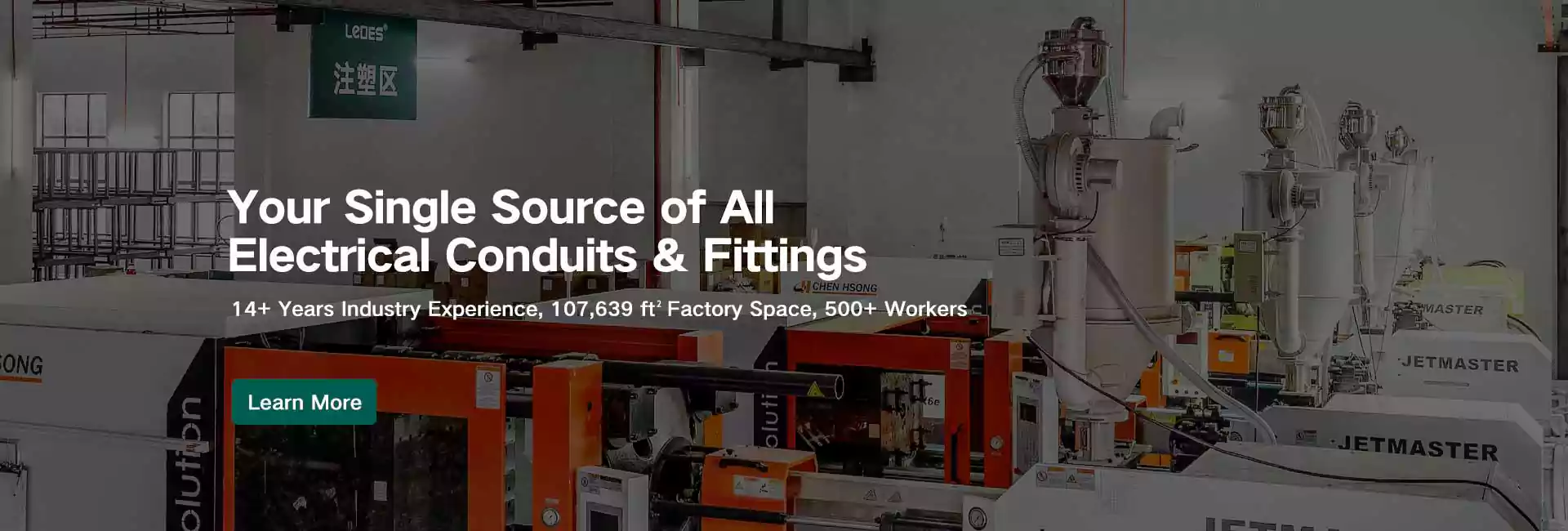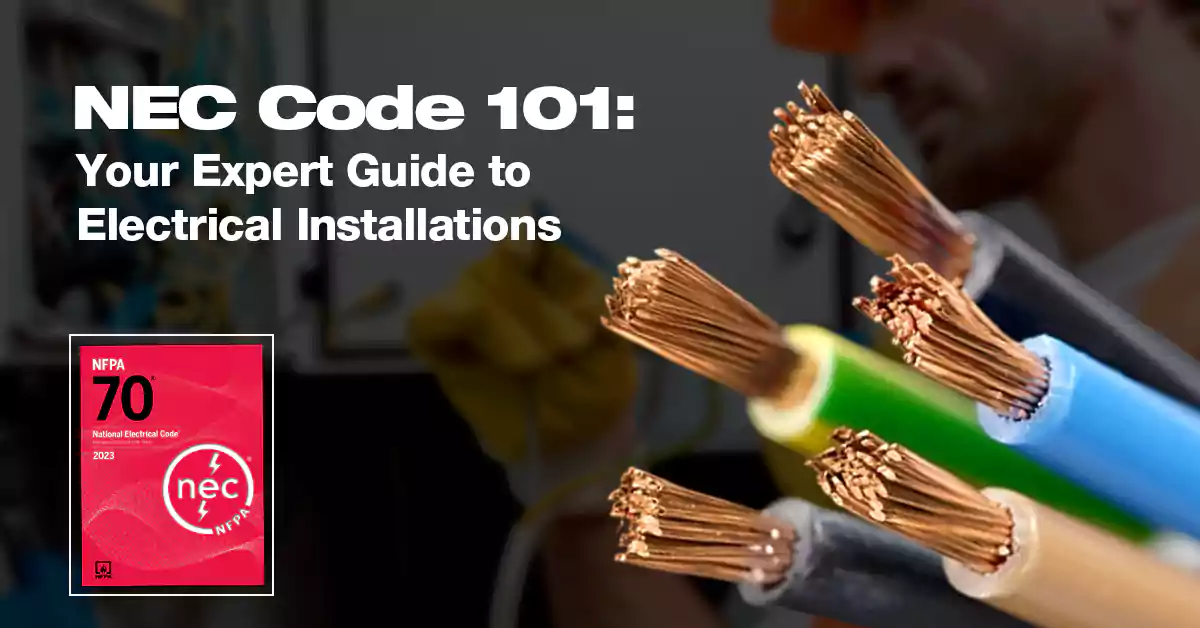
Tabla de contenido
What Is the NEC Code?
The National Electrical Code (NEC) is the benchmark standard for safe electrical design, installation, and inspection in the United States. It serves as the foundation for nearly all electrical regulations in residential, commercial, and industrial settings. Whether you’re wiring a new home, installing an industrial motor, or running conduit for a solar array, the NEC sets the rules that help protect people and property from electrical hazards.
The NEC is formally known as NFPA 70, published by the National Fire Protection Association (NFPA) – a nonprofit organization dedicated to reducing fire and electrical risks. First introduced in 1897, the code has evolved alongside advancements in electrical systems, becoming more comprehensive with each update.
To ensure it reflects modern technologies and safety practices, the NEC is revised every three years by panels of experts, including electricians, engineers, inspectors, manufacturers, utility representatives, and safety advocates. The most current version is adopted by state and local jurisdictions, making the NEC a legally enforceable standard in most areas of the U.S.
The scope of the NEC is broad but clearly defined. It covers:
- The installation of electrical conductors and equipment
- Wiring methods, including electrical conduit and raceways
- Special considerations for various environments and occupancies
In short, the NEC governs how electrical systems must be installed to ensure safety and compliance.
Consejos profesionales: Want to understand NEC Code requirements for PVC conduit quickly? You can click here to get expert insights on NEC code for PVC conduit.
Purpose and Meaning of the NEC Code
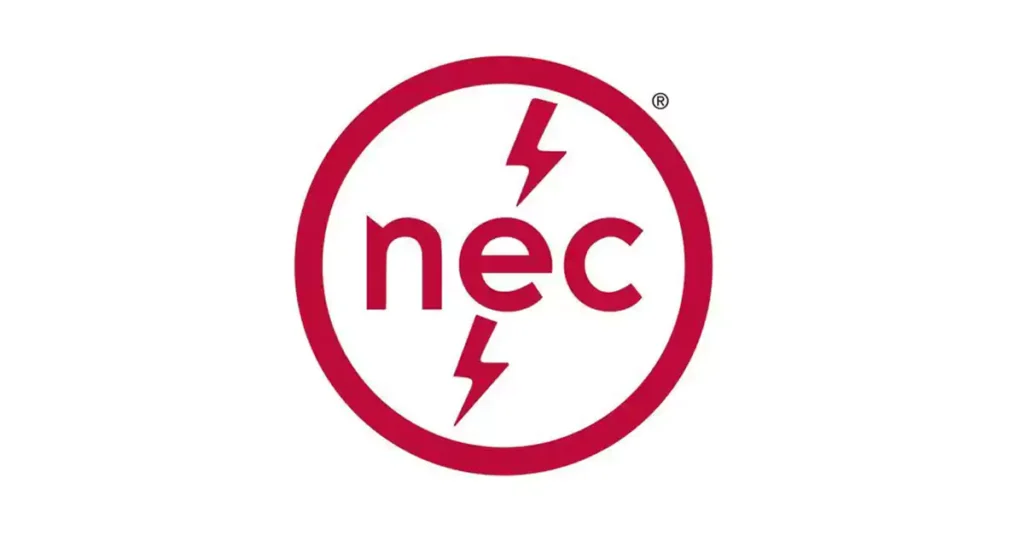
At its core, the National Electrical Code (NEC) exists to ensure safety. Its primary goal is to protect people and property from electrical hazards such as electric shock, fires, arc flashes, and equipment failures. It accomplishes this by setting minimum requirements for the safe installation of electrical systems in a wide variety of settings – from homes and schools to factories and power plants.
The Purpose of the NEC
The NEC is not about over-regulation; it’s about minimum safety standards. It ensures that all licensed electricians and inspectors follow the same foundational rules, regardless of region or project type. By adhering to these standards, electrical professionals reduce the risk of catastrophic accidents and ensure system reliability over the long term.
While the NEC might seem complex at first glance, its structure is methodical and its intent is straightforward:
“The practical safeguarding of persons and property from hazards arising from the use of electricity.” (NEC Article 90.1)
This statement summarizes the NEC’s mission. Whether you’re installing conduit, setting up a panelboard, or wiring a lighting circuit, the NEC provides a clear framework for doing it safely.
Understanding Code Language
The NEC uses specific wording that carries legal and technical weight. Understanding this language is key to applying the code correctly:
“Shall” = Mandatory. A requirement that must be followed.
“Should” = Recommended. Not enforceable, but considered best practice.
“May” or “Permitted” = Optional or allowable within limits.
For example, “Conduit shall be supported within 3 feet of each outlet box” means this spacing is a requirement, not a suggestion.
NEC - A Living Document
The NEC is updated every three years to reflect new technologies, improved materials, safety findings, and industry best practices. Each edition incorporates changes based on real-world feedback and innovations, such as:
- Integration of solar photovoltaic (PV) systems
- Rules for electric vehicle charging stations
- Standards for low-voltage and smart systems
Because of this ongoing development, the NEC isn’t just a static rulebook. It’s a living, evolving document that adapts to modern needs while staying rooted in its mission: keeping people safe.
It’s important to remember that the NEC sets the minimum acceptable standards. In many cases, best practices or engineering specifications may exceed these requirements for added safety, longevity, or performance, especially in critical facilities or harsh environments.
Key Sections of the NEC Code
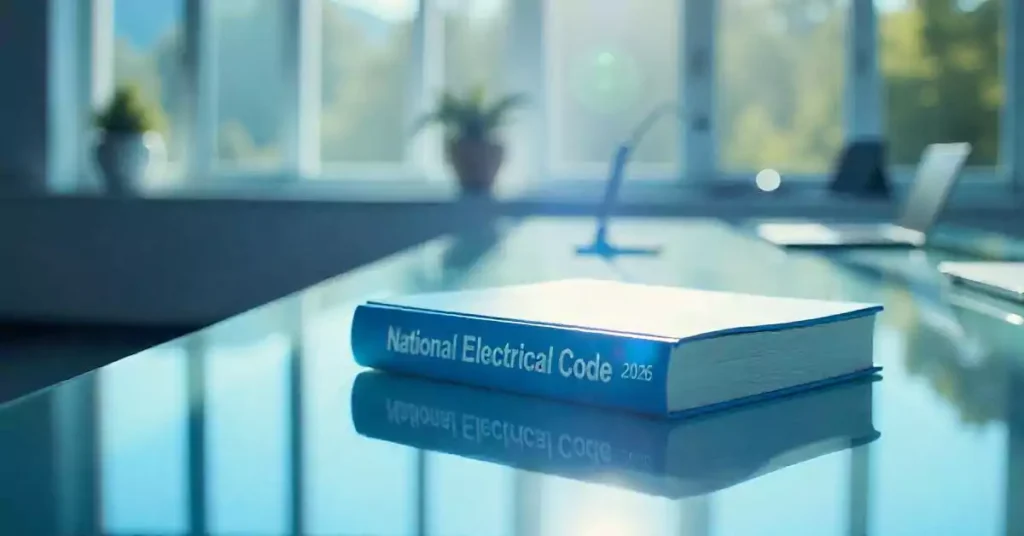
The National Electrical Code (NEC) is divided into several Articles, each focusing on specific aspects of electrical systems. While the NEC is extensive, spanning hundreds of pages and numerous rules, some core sections appear across nearly every project or installation type. Understanding these key Articles provides a strong foundation for code compliance and safe electrical design.
Chapter 1 - General Requirements for Electrical Installations
Chapter 1 of the National Electrical Code (NEC) forms the structural and definitional backbone of the entire code. It includes Articles 100 and 110, which define key terms and establish the fundamental installation requirements for all electrical systems. These general provisions apply across residential, commercial, industrial, and special-purpose installations.
Article 110 lays out the general requirements for all electrical equipment and installation conditions. It covers critical areas such as mechanical integrity, voltage rating, environmental suitability, accessibility, and clearances. Some key highlights include:
Modifications and Available Fault Current
One of the most critical updates comes from Section 110.24(B), which directly addresses system modifications:
If changes are made to an electrical installation that affect the available fault current at the service, the following is required:
- The available fault current must be verified or recalculated.
- Service equipment must be rated appropriately to handle the updated fault current at its line terminals.
- Field markings must be updated to reflect the new available fault current (some cases are not required, check Article 110.24).
This is a safety-critical rule designed to ensure that equipment ratings stay in line with changing load and fault conditions. If a system’s short-circuit current increases and the panel isn’t updated or relabeled, the risk of catastrophic failure increases.
Clearances and Working Space
The code prescribes minimum working space dimensions around electrical panels and equipment:
- A minimum depth of 3 feet is required in front of panels (depending on voltage).
- The workspace must be clear, accessible, and adequately lit.
- No plumbing or foreign systems may intrude on this area.
These clearances ensure safe operation and maintenance by personnel.
Labeling and Identification
Disconnects must be clearly labeled.
Equipment must bear markings indicating its voltage, current, wattage, or other rating.
When required, field-applied hazard markings must be durable, visible, and permanent.
Environmental Ratings
Equipment must be suited for the environment in which it’s installed. For instance:
Indoor equipment cannot be installed outdoors unless it is NEMA rated for outdoor use.
In wet locations, weatherproof enclosures and conduit fittings must be used.
Conduit and fittings should be resistant to corrosion, UV radiation, and temperature variations, depending on location.
Chapter 2 – Wiring and Protection
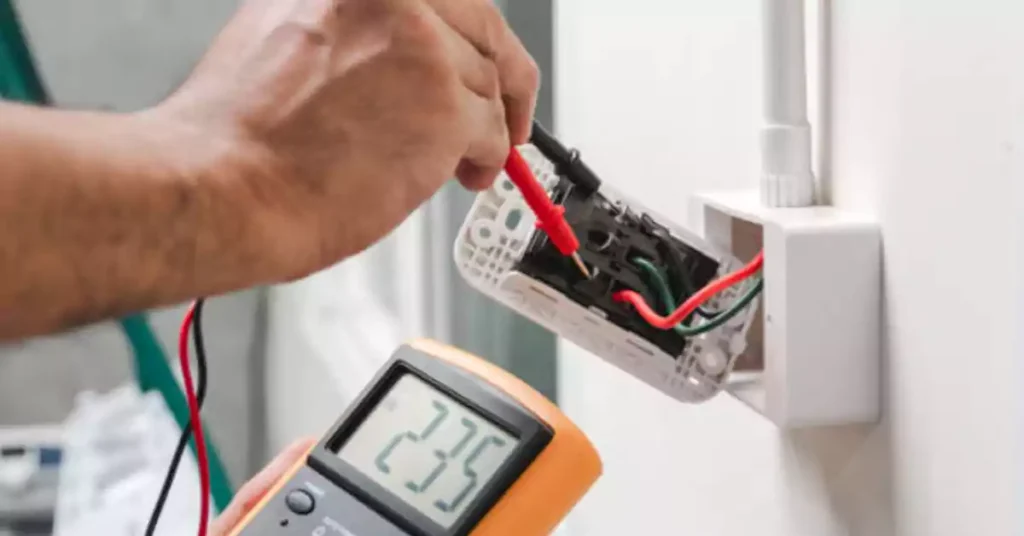
Chapter 2 of the National Electrical Code (NEC) is one of the most critical sections for electrical safety. It lays out comprehensive requirements for the proper identification, arrangement, and protection of electrical conductors and circuits. The primary goal of this chapter is to ensure that all wiring systems are not only functional but also safe from hazards such as electrical shock, overheating, fire, and short circuits.
About Branch Circuits
Article 210 - Circuits not over 1000 volts AC or 1500 volts DC
General Rules for Voltage and Conductor Identification: For DC branch circuits over 60 volts, conductors must be clearly marked by polarity using approved means like red or black outer finishes or permanent labels.
GFCI Protection Requirements: GFCI (Ground-Fault Circuit Interrupter) protection is mandated for many receptacles in locations prone to moisture or physical contact with water. This includes kitchens, bathrooms, rooftops, basements, laundry areas, and industrial aquatic environments. Several exceptions are listed for special conditions, such as industrial labs, snow-melting systems, or health care facilities.
Branch Circuits from DC Systems: Conductors must be marked at all terminations, connections, and splices, with special considerations for size (above or below 4 AWG) and polarity marking.
Article 235 – Branch Circuits Over 1000 Volts
Article 235 supplements Article 210 for circuits exceeding 1000 volts AC or 1500 volts DC. Like 210.3, it includes a Table 235.3 referencing specific equipment (e.g., motors, busways, HVAC systems) where additional protective requirements apply.
Supervised Installations
In high-voltage environments, branch-circuit conductor sizing may be determined under the guidance of engineering professionals. Supervised installations must meet both of the following:
- Design and installation under engineering supervision.
- Maintenance and service performed by trained personnel with documented experience in high-voltage systems.
This provision helps streamline advanced systems while ensuring that only qualified professionals handle their design and upkeep.
Protección contra sobrecorriente
Overcurrent protection is essential to prevent damage caused by overloads, short circuits, and ground faults. NEC Article 240 outlines detailed provisions including:
Protection Devices and Accessibility
Circuit breakers and fused switches must be readily accessible, with handle heights not exceeding 2.0 m (6 ft 7 in.), unless specific exceptions apply (e.g., busways, hazardous enclosures, or where portable access is permitted).
Multiwire Branch Circuits
For multiwire circuits serving single-phase, line-to-neutral loads, individual single-pole breakers with handle ties are permitted to protect each ungrounded conductor, ensuring simultaneous disconnecting.
Tap Conductors
Outside Taps of Unlimited Length (240.21(B)(5)): The NEC permits outside tap conductors of unlimited length, provided they meet strict conditions including protection from physical damage, termination in a single overcurrent device, and placement of the disconnecting means at a readily accessible location nearest to the conductor entrance.
Noninterchangeable Fuses
Type S fuses are designed to prevent interchangeability with lower-rated fuses, enhancing system safety by ensuring only properly rated fuses are installed.
Transformer Secondary Conductor Protection
Overcurrent protection for transformer secondary conductors depends on transformer configuration. Certain configurations, like single-phase 2-wire or 3-wire delta-delta, may be protected via primary OCPD, provided conditions in 450.3 and ampacity limits are satisfied.
Reconditioned Equipment
Specific overcurrent protection devices such as low-voltage power circuit breakers and electromechanical relays may be reconditioned, but must be listed as reconditioned and marked accordingly to comply with 110.21(A)(2).
Overvoltage Protection
Overvoltage protection is critical in safeguarding electrical systems from transient voltage surges such as those caused by lightning strikes, utility switching, or internal system faults. In Chapter 2 of the NEC, overvoltage protection is addressed under Article 242, which specifies the general and installation requirements for Surge-Protective Devices (SPDs) and surge arresters.
Article 242 covers both low-voltage and high-voltage surge protection:
- Part II governs SPDs permanently installed on premises wiring systems not exceeding 1000 volts (nominal).
- Part III addresses surge arresters installed on premises systems over 1000 volts (nominal).
Requirements for SPDs and Surge Arresters
No Reconditioning Permitted (242.2): To ensure reliability and safety, SPDs and surge arresters are not allowed to be reconditioned. They must always be used as originally manufactured and listed.
Grounding Requirements (242.32): SPD grounding connections must comply with Article 250, Part III, ensuring proper bonding to the grounding electrode system. When grounding electrode conductors are run in metal enclosures, they must meet the specific conditions outlined in 250.64(E), such as proper bonding and protection from physical damage.
Manufacturer Installation for Component SPDs (242.18): Type 4 SPDs and other component-type surge devices are not intended for field installation. They must only be installed by the original equipment manufacturer, as these devices are integrated into equipment and not standalone field-installed products.
Puesta a tierra y unión
Grounding and bonding are foundational to the safe and reliable operation of electrical systems. NEC Chapter 2, specifically Article 250, establishes the performance and prescriptive requirements to ensure that electrical systems are grounded and bonded in a way that protects both people and property from electric shock, fire, and equipment damage.
Purpose and General Requirements
The general goals of grounding and bonding are to:
Limit voltage imposed by lightning, line surges, or unintentional contact with higher-voltage lines.
Stabilize voltage to earth during normal operation.
Establish a low-impedance path to facilitate the operation of overcurrent protection devices during a ground fault.
Five Major Performance Requirements
- Grounding of Electrical Systems: Systems that are grounded must be connected to earth in a way that limits voltage surges and stabilizes voltage. The NEC emphasizes minimizing the length and avoiding unnecessary bends or loops in grounding electrode conductors.
- Grounding of Electrical Equipment: Non-current-carrying conductive parts (e.g., metal enclosures) must be grounded to limit voltage on those materials.
- Bonding of Electrical Equipment: All conductive parts enclosing conductors must be connected together and to the supply system ground to form a continuous, effective fault-current path.
- Bonding of Conductive Materials and Other Equipment: Conductive materials likely to become energized (e.g., piping, structural steel) must be bonded to the grounding system.
- Effective Ground-Fault Current Path: Grounding and bonding conductors must form a continuous low-impedance circuit capable of safely carrying fault current. Notably, the earth is not considered an effective ground-fault current path.
Grounding Requirements for AC Systems
Grounding is required for most alternating-current systems based on system voltage and configuration:
Systems less than 50V must be grounded if:
Supplied by a transformer whose primary system exceeds 150V to ground.
The system is ungrounded.
Installed outdoors as overhead conductors.
Systems between 50V and 1000V must be grounded if:
The voltage to ground on any conductor exceeds 150V.
The system is 3-phase, 4-wire wye-connected with a neutral used as a circuit conductor.
The system is 3-phase, 4-wire delta-connected with a midpoint used as a circuit conductor.
Systems not meeting these conditions may be permitted to operate ungrounded, but they must still comply with relevant NEC safety and maintenance standards.
Special Grounding Considerations
Impedance Grounded Systems: These must follow the specific requirements in 250.36 or 250.187, which limit fault current using resistors or reactors.
Outdoor Transformers: Where a transformer is located outdoors, at least one additional grounding electrode connection is required at the transformer or another outdoor location—except for impedance-grounded systems.
Separately Derived Systems: These systems, such as transformers, require their own grounding electrode connection and must follow detailed rules for bonding and conductor sizing.
Grounding Electrode System: All grounding electrodes present must be bonded together to form a grounding electrode system, including rods, plates, concrete-encased electrodes, and building steel.
Bonding for Services: Metal enclosures and raceways for service conductors must be bonded to provide a continuous path back to the source.
Chapter 3 – Wiring Methods and Materials
Chapter 3 of the NEC addresses how electrical conductors are to be routed, supported, and protected, as well as which types of cables, raceways, and enclosures are permitted under different conditions. It sets technical and installation standards for wiring systems based on factors such as voltage level, location (indoors or outdoors), environmental exposure, mechanical protection, and more.
Article 300 provides foundational rules for all wiring methods in the NEC, unless modified by a more specific article. It applies to raceways, cable assemblies, enclosures, boxes, and conductor installations. This article emphasizes safety, accessibility, durability, and proper separation from other systems. Here are some key aspects of this Chapter:
Key Provisions
- Protección mecánica: Conductors and cables must be protected from physical damage. For example, where they pass through metal studs or framing, bushings or grommets must be used.
- Spacing from Other Systems: Electrical raceways cannot contain other types of systems (e.g., plumbing, gas piping).
- Working Space and Access: Sufficient conductor length (at least 6 inches) must be available at outlets and junction boxes for splicing or termination.
- Corrosive and Damp Environments: Wiring methods must be listed for use in wet, damp, or corrosive locations (e.g., PVC conduit with corrosion-resistant fittings).
- Raceway Fill and Bending Radius: Overfilling raceways is prohibited, and conductors must have sufficient bending space to avoid insulation damage.
- Fire Separation: Openings around raceways or cables that penetrate fire-rated assemblies must be fire stopped to prevent fire spread.
Consejos profesionales: Want to know the two common wiring methods? In the previous article, we explained in detail Concealed Conduit Wiring y Surface Conduit Wiring. You can click on the text above to learn about their advantages and disadvantages, and installation methods.
Conductors for General Wiring
Article 310 specifies the types, characteristics, and ratings of electrical conductors used for most wiring installations in residential, commercial, and industrial systems.
It covered:
- Conductor Types: Allows solid or stranded copper, aluminum, or copper-clad aluminum conductors.
- Insulation Types: Common insulation types include:
THHN/THWN-2: Dry and wet locations, up to 90°C
XHHW/XHHW-2: Moisture- and heat-resistant
USE-2/RHH/RHW-2: Underground and service entrance use
- Ampacity: Conductor ampacity (current-carrying capacity) is defined based on:
Conductor size
Insulation temperature rating
Ambient temperature
Number of current-carrying conductors in a raceway
- Voltage Rating: Conductors are listed by their maximum voltage (e.g., 600V, 1kV).
- Parallel Conductors: For large conductors (1/0 AWG or larger), multiple conductors in parallel are permitted to achieve higher ampacity.
Articles 342 to 362 – Conduit and Tubing Types
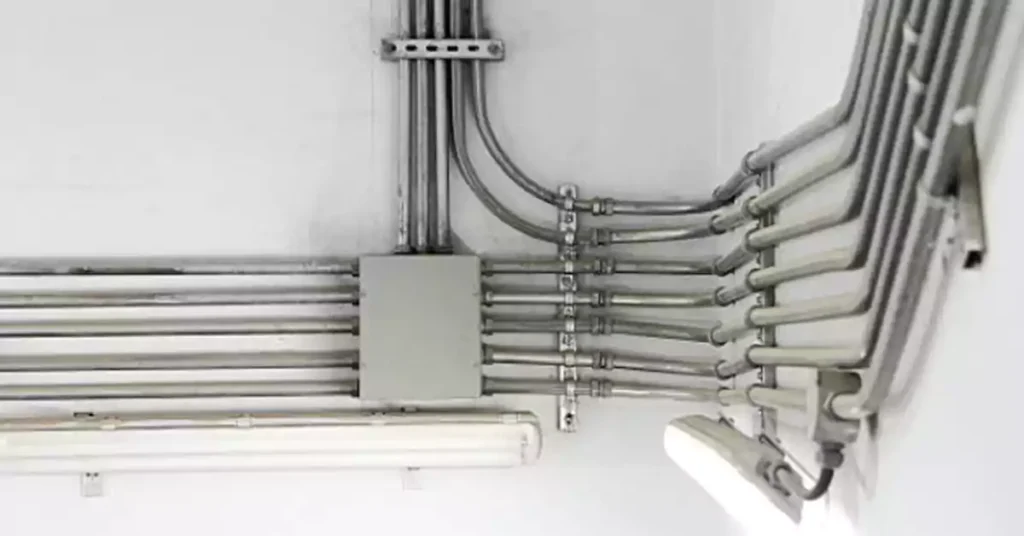
The NEC provides individual articles for each raceway system based on material, construction, and application. These raceways are used to physically protect conductors, support grounding continuity, and allow conductor routing in compliance with Article 300.
Here are 7 types conduit in NEC code:
Conducto metálico intermedio (IMC)
IMC is a steel conduit with a thinner wall than Rigid Metal Conduit (RMC) but offers comparable mechanical protection. It is galvanized for corrosion resistance and approved for use in exposed, concealed, and hazardous locations. IMC is a popular choice for outdoor or industrial settings where strength is required but weight and cost are considerations.
Conducto de metal rígido (RMC)
RMC is the heaviest and most robust metallic conduit, made from galvanized steel or stainless steel. It is designed for maximum physical protection and can be installed in all environments, including exposed and underground locations. RMC is often used in high-risk areas, such as critical infrastructure, petrochemical plants, or areas subject to mechanical abuse or severe corrosion.
Rigid Polyvinyl Chloride Conduit (PVC)
Conducto de PVC rígido is a nonmetallic raceway made from plastic and is resistant to moisture and corrosion. It is lightweight, easy to cut, and ideal for underground installations, wet environments, and corrosive conditions such as wastewater treatment plants or coastal regions. PVC conduit must be used with expansion fittings when exposed to temperature changes and is typically joined using solvent cement.
High-Density Polyethylene Conduit (HDPE)
HDPE conduit is a flexible, nonmetallic conduit with excellent impact resistance and flexibility. It is typically used for underground power and communication systems, including directional boring installations. HDPE’s ability to be installed in long continuous lengths with fewer joints makes it efficient for large-scale utility and infrastructure projects.
Tubería Metálica Eléctrica (EMT)
Commonly referred to as “thin-wall” conduit, EMT is made of galvanized steel or aluminum and is lighter than both IMC and RMC. It is widely used in commercial buildings, particularly for indoor applications in walls and ceilings where moderate protection is sufficient. EMT must be mechanically secured and is joined using compression or set-screw fittings. It is not approved for direct burial or corrosive environments without additional protection.
Tubos metálicos flexibles (FMT)
FMT consists of spirally wound metal tubing that offers flexibility for short, complex routing paths. It is used in situations where vibrations, movement, or space constraints make rigid conduit impractical. Typical applications include fixture whips, motor connections, and tight enclosures. It is not suitable for wet or hazardous locations unless specifically listed.
Tubería eléctrica no metálica (ENT)
Otorrinolaringología is a corrugated, flexible plastic tubing used for indoor applications where fast installation is critical. It is lightweight, non-metallic, and can be bent by hand, making it ideal for use in walls, floors, and ceilings of residential or commercial buildings. ENT is commonly used in fire-resistant construction when paired with appropriate fittings and boxes, and it simplifies installation in slab-on-grade or poured concrete construction.
General Requirements for Conduit Installations:
Must be securely supported and fastened at specific intervals.
Proper bushings or fittings must be used to protect conductors.
Conduit must be free of sharp edges and sealed where required to prevent moisture or gas ingress.
Expansion fittings are required in long outdoor runs subject to temperature changes (e.g., PVC conduit).
Each of these conduit types is governed by specific installation rules in the NEC, ensuring that wiring systems are protected, secure, and code-compliant. Selecting the correct conduit type not only preserves electrical system integrity but also ensures safety across a range of environmental conditions.
Notas: Want to know the details of PVC conduit installation? You can click here to get pro tips on PVC conduit installation.
Article 392 - Cable Trays
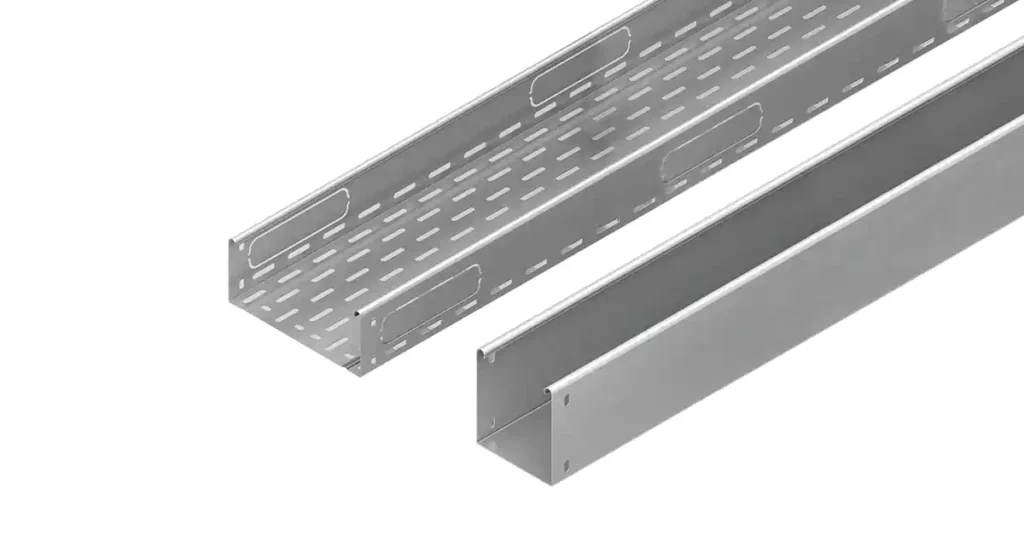
Cable trays are structural support systems for routing and supporting cables in industrial and commercial settings. Article 392 covers the design, installation, and use of cable tray systems, which include ladder, ventilated trough, solid bottom, and wire mesh trays.
Types of Cable Tray
Ladder Tray: Open rungs allow air circulation and easy cable entry/exit.
Ventilated Trough: Partial enclosure for medium support and airflow.
Solid Bottom Tray: Fully enclosed, used when mechanical protection is key.
Wire Mesh/Basket Tray: Lightweight, quick to install, good for control and data cables.
NEC Requirements for Cable Tray
Ampacity Adjustments: Cables installed in trays may require ampacity derating based on fill and ventilation.
Fill Calculations: Tray fill limits are based on cable types and sizes—excessive fill can reduce heat dissipation.
Toma de tierra: Metallic trays can be used as an equipment grounding conductor (EGC) if listed and bonded properly.
Espaciado de soporte: Trays must be supported at regular intervals to prevent sagging or damage.
Consejos profesionales: Confused about choosing between Conduit and Trunking? Don’t worry, you can read this post to quickly understand the difference between conduit and trunking, as well as their pros and cons, to help you choose the right one.
Chapter 5 - Special Occupancies
Chapter 5 of the National Electrical Code (NEC) focuses on Special Occupancies – locations and structures that present unique electrical installation challenges due to their function, contents, or environment. Chapter 5 modifies the general rules to meet the specific needs of hazardous, medical, agricultural, mobile, and recreational occupancies, among others.
Hazardous (Classified) Locations
Hazardous locations are areas where flammable gases, vapors, dusts, or fibers may be present in sufficient quantities to create the risk of fire or explosion. The NEC classifies these areas using a Class, Division, and Group system or a Zone system, depending on the type of hazard.
- Common settings include chemical plants, fuel storage areas, flour mills, and spray finishing zones.
- Approved wiring methods include explosionproof enclosures, seal-offs, and the use of specific conduit systems such as RMC, IMC, and Type PVC with special fittings.
- Equipment must be listed and labeled for the environment, and installation techniques must limit the entry of hazardous substances into wiring systems.
Centros de atención médica
Health care facilities present life-critical demands for electrical reliability and patient safety. Article 517 covers hospitals, nursing homes, clinics, and similar environments.
- It introduces Essential Electrical Systems that include life safety, critical, and equipment branches, each with specific installation and separation requirements.
- Wiring must reduce the risk of electrical faults, interference with medical equipment, and fire hazards.
- Requirements for grounding, redundancy, isolated power systems, and conduit types are precisely defined to maintain performance and compliance.
Agricultural Buildings
Article 547 governs electrical systems in agricultural and livestock environments, where high moisture, dust, and corrosive agents like ammonia can degrade typical wiring.
- Wiring must be protected from physical damage and corrosive exposure using corrosion-resistant conduit and fittings, such as PVC-coated or nonmetallic materials.
- Bonding and grounding systems must minimize voltage gradients, which can harm livestock.
- This article also addresses the installation of lighting, receptacles, and equipment control in animal confinement areas and crop production spaces.
Manufactured Buildings and Mobile Homes
These articles cover the electrical requirements for factory-built structures, such as manufactured homes, mobile homes, modular buildings, and mobile home parks.
Electrical systems must allow safe and standardized connection to utility services.
Requirements include overcurrent protection, proper grounding, and use of approved flexible connections.
Parks and lots must provide weather-resistant and easily accessible service equipment, ensuring safe occupancy transitions.
Recreational Vehicles and Parks
These sections provide guidelines for recreational vehicles (RVs) and the facilities that serve them.
Wiring in RVs must be compact, safe, and protected from vibration and movement.
RV parks must provide power distribution systems with listed power outlets, overcurrent protection, and grounding suitable for mobile connections.
All components must be weatherproof and tamper-resistant when installed in outdoor settings.
Chapter 5 plays a critical role in ensuring that electrical installations remain safe, code-compliant, and functional in non-standard environments, above are just part of them. It recognizes that certain occupancies present elevated risks, such as explosion, equipment failure, or life safety threats—that demand specialized materials, installation methods, and protective measures.
Chapter 6 - Special Equipment
Chapter 6 of the National Electrical Code (NEC) addresses Special Equipment — a vital section that sets the safety and installation standards for emerging technologies and specialized systems. With rapid growth in electric vehicles, renewable energy, and modular data centers, this chapter is more relevant than ever. Below is an introduction to four important articles within Chapter 6:
Article 625 - Electric Vehicle Power Transfer Systems
Article 625 covers the installation and safety requirements for electric vehicle (EV) charging systems, including conductive, inductive, and wireless power transfer methods. It addresses equipment such as electric vehicle supply equipment (EVSE), connectors, and associated wiring. Key provisions include:
Scope: Applies to electrical conductors and equipment connecting an EV to premises wiring for charging, power export, or bidirectional current flow.
Equipment Requirements: EVSE must be listed or labeled for the application.
Protección contra sobrecorriente: Charging equipment is considered a continuous load; overcurrent protection must be sized accordingly.
Personnel Protection: Requirements for personnel protection systems, such as ground-fault circuit-interrupter (GFCI) protection.
Installation Guidelines: Specifications for cord and cable assemblies, including length and construction.
Location Considerations: Installation guidelines for indoor and outdoor locations, considering factors like ventilation and accessibility.
Notas: Want to know more about EV Charging Systems Codes? We listed four international standards for EV Charging Stations in our previous post, and you can click on the text above to read.
Article 646 – Modular Data Centers
Article 646 provides requirements for modular data centers (MDCs), which are prefabricated units housing information technology equipment and support systems. These units are rated 600 volts or less and include components like electrical service distribution equipment and HVAC systems. Key considerations include:
Definition: MDCs are prefabricated units consisting of an outer enclosure housing multiple racks or cabinets of IT equipment and various support equipment.
Listing and Labeling: MDCs must be listed and labeled for their intended use.
Working Space: Compliance with working space requirements to ensure safety during maintenance and operation.
Wiring and Grounding: Adherence to wiring methods and grounding practices suitable for the modular nature of these facilities.
Consejos profesionales: Want to know more about the types of electrical conduits and their applications in data centers? We have explained in detail the importance of electrical conduits and their applications in data centers in our last post. You can click on the text above to read more.
Article 690 - Solar Photovoltaic (PV) Systems

Article 690 provides the installation requirements for solar photovoltaic (PV) systems, excluding large-scale utility PV systems (covered by Article 691). It governs the PV array circuits, inverters, controllers, disconnects, grounding, and interconnections—whether stand-alone, interactive with other power sources, or hybrid—producing either AC or DC power.
Key highlights include:
Scope and Applicability: Covers residential, commercial, and industrial PV systems except for utility-scale stations. Multiple PV systems are allowed on a single structure with appropriate labeling and directories.
Equipment Requirements: PV components (e.g., inverters, modules, combiner boxes, rapid shutdown systems) must be listed or evaluated for the specific PV application.
Circuit and Voltage Requirements: Limits DC voltage to 1000V (600V for one- and two-family dwellings); conductor ampacity and maximum circuit currents must be carefully calculated; special provisions apply to bipolar circuits and systems with multiple voltages.
Arc-Fault and Ground-Fault Protection: DC circuits over 80V must have arc-fault protection; ground-fault protection (GFDI) is required for systems over 30V or 8A unless exempted.
Rapid Shutdown: Required for PV circuits on or in buildings to ensure firefighter safety—exceptions apply to ground-mounted and non-enclosed structures like carports.
Desconectar significa: PV systems must have clearly labeled and accessible means to disconnect from other electrical and storage systems.
Wiring Methods and Accessibility: PV conductors over 30V that are accessible must be enclosed (e.g., MC cable or raceways); power converters can be installed on rooftops if disconnecting means are accessible.
Floating PV Systems: Must be suitable for increased mechanical stress, corrosion, and humidity, and allow for expected movement on water.
Conexión a tierra y unión: Allows functionally grounded, ungrounded, and solidly grounded DC circuit configurations with detailed grounding requirements for safety.
Consejos profesionales: Wait, besides NEC, are there other electrical codes to comply with? In the last article, we explained in detail about the types and code compliance of solar conduits. You can click on the text above to read more.
Article 694 – Wind Electric Systems
Article 694 of the NEC establishes the requirements for wind electric systems, including one or more wind turbines and associated equipment such as generators, inverters, controllers, and energy storage. These systems may operate independently or interact with other power sources, and may produce AC or DC output.
Key provisions include:
Qualified Personnel: Installation, wiring, and maintenance must be performed by qualified individuals.
Equipment Listing: Wind turbines and related components must be listed, field-labeled, or under supervised evaluation.
Overvoltage and Overspeed Protection: Systems using diversion load controllers must include a reliable secondary method to prevent turbine overspeed. Surge protective devices are required.
Receptacles: Maintenance receptacles must include GFCI protection and overcurrent protection.
Circuit Requirements: Output circuits are treated as continuous loads, with voltage and access limitations in residential settings.
Shutdown and Disconnect: Systems must include means for turbine shutdown and disconnection.
Wiring and Grounding: All wiring methods and bonding must follow NEC requirements for safety and system stability.
Chapter 7 - Special Conditions
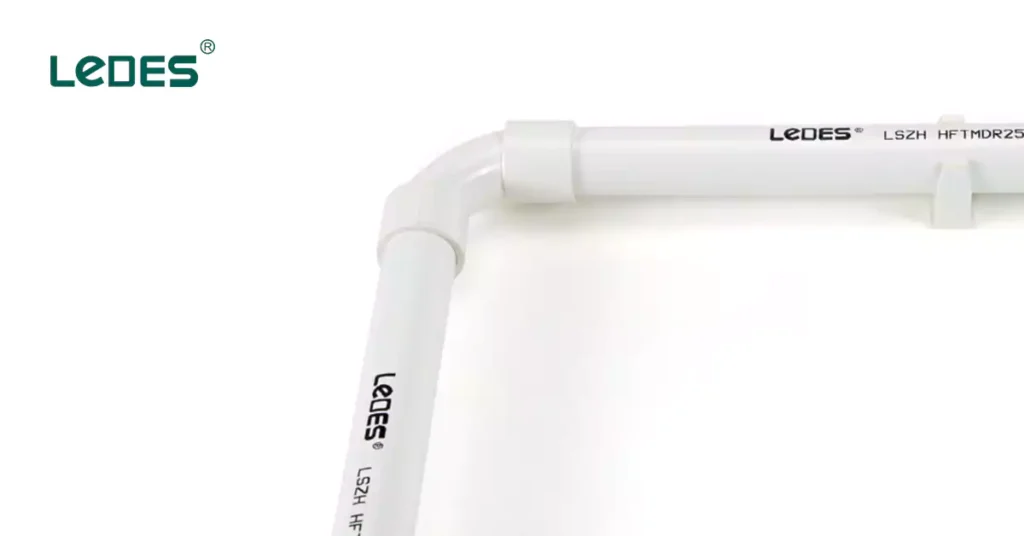
Chapter 7 of the National Electrical Code (NEC) addresses Special Conditions—those electrical systems that either support life safety, operate during abnormal situations, or involve emerging technologies. This chapter is crucial for systems that require continuous, backup, or alternative sources of power, as well as systems designed for monitoring or signaling.
From emergency systems and legally required standby power to energy storage and fire alarms, Chapter 7 provides clear installation requirements to ensure reliability, safety, and code compliance.
Article 700 - Emergency Systems
Emergency systems are legally required electrical systems that must continue operating in the event of a power outage to protect human life and safety. These include systems powering exit signs, emergency lighting, fire detection and alarms, public safety communications, and critical ventilation.
Key requirements include:
Transfer Time: Automatic transfer switches to ensure power is restored within 10 seconds of an outage.
Circuit Separation: Emergency wiring must be physically separated from all other wiring systems unless in separate compartments.
Use of listed and reliable sources like generators or battery systems.
Cumplimiento with testing, maintenance, and identification standards to ensure availability during emergencies.
Article 701 - Legally Required Standby Systems
Legally required standby systems are mandated by local or national laws to maintain certain functions during power outages, but they are not as critical as emergency systems. These may support systems like elevators, HVAC, and sewage pumps in larger buildings.
Highlights:
Power restoration must occur within 60 seconds of a utility power loss.
These systems must be separately identified and installed.
Fuel supply, ventilation, and control systems must meet specific operating time and reliability standards.
Article 706 - Energy Storage Systems (ESS)
With the rise of renewable energy and grid resilience efforts, energy storage systems (ESS) such as battery banks, flywheels, and ultracapacitors have become a critical part of modern installations. Article 706 is a newer addition to the NEC and covers the installation, protection, and labeling of ESS.
Key points include:
Instalación: ESS must be installed per manufacturer’s instructions and Chapter 706 provisions.
Battery Types: Requirements vary based on chemistry:
Lithium-ion: Must include thermal runaway prevention and fire-resistant enclosures.
Lead-acid: Requires ventilation and spill containment.
Location Limits: ESS must be installed in approved rooms or cabinets, with required clearances and ventilation.
Shutdown Protocols: Systems must have clearly labeled, accessible emergency shutdown mechanisms.
Consejos profesionales: Is your business in the Energy Storage Systems (ESS) industry? In the last post, we listed four international standards and 7 tips to comply with them. You can click on the text above to learn more.
Article 760 - Fire Alarm Systems
Fire alarm systems are required for life safety, alerting occupants and emergency personnel to smoke or fire events. Article 760 outlines the wiring and installation rules for both power-limited and non–power-limited fire alarm circuits.
Key highlights include:
Circuit Types: Divided into:
Power-limited fire alarm (PLFA): Lower voltage; uses specific cable types (e.g., FPL, FPLP, FPLR).
Non–power-limited fire alarm (NPLFA): Higher power requirements; must follow general wiring rules.
Protección del cable: Fire alarm cables must be:
Listed for fire resistance and routed to avoid physical damage.
Separated from other systems unless barriers are used.
Fuente de alimentación: Must have primary and secondary (backup) power, usually batteries capable of 24 hours standby and 5 minutes alarm operation.
Calificación: Junction boxes and conduits must be marked “FIRE ALARM CIRCUIT”.
Article 770 - Optical Fiber Cables and Raceways
Though not a traditional power system, optical fiber cables are vital for modern communication and control systems. Article 770 details the installation requirements for nonconductive and conductive fiber optic cables.
Covers fire-rated cable types (OFNR, OFNP).
Includes rules for raceways, bends, support spacing, and mechanical protection.
Emphasizes maintaining signal integrity and minimizing damage risks in high-performance networks.
Additional Best Practices for Special Conditions
While each Article within Chapter 7 includes highly specific requirements, some general best practices include:
- Documentation and Labeling:
Clearly label all systems, especially those involved in life safety or standby operation.
Maintain installation records, drawings, and test results as required by NFPA 70 and local AHJs (Authorities Having Jurisdiction).
- Consideraciones ambientales:
Systems located in wet, corrosive, or explosive environments (like those in combination with Chapter 5) must use listed enclosures, corrosion-resistant materials, and NEMA-rated equipment.
- Coordination with Other Codes:
Fire alarm and emergency systems must comply not just with NEC but also with NFPA 72 (National Fire Alarm and Signaling Code) and NFPA 110 (Standard for Emergency and Standby Power Systems).
- Maintenance & Testing:
Chapter 7 systems require ongoing inspection and testing, sometimes monthly, to meet compliance. System failures during emergencies often stem from lack of maintenance.
Chapter 8 - Communications Systems
NEC Chapter 8 provides the rules and requirements for communication circuits, including telephone systems, television and radio distribution, internet/data cabling, intercoms, and networked control systems. Unlike power circuits regulated in earlier chapters, Chapter 8 focuses specifically on low-voltage systems designed to transmit information, not power.
Article 800 - General Requirements for Communications Systems
This article outlines the general rules for installing communication cables and related hardware, including:
- Cable Types and Ratings:
Communications cabling includes types like CM, CMR, CMP, and CAT5e/CAT6/CAT6A for data.
Fire ratings matter: CMP cables (plenum rated) are required in ducts or plenum spaces due to fire safety concerns.
- Separation from Power Wiring:
Communication cables must be separated from power and lighting conductors to avoid electrical interference and induced voltages.
Dedicated raceways, barriers, or spacing are often required when running parallel to power circuits.
- Conexión a tierra y unión:
All communications systems must be grounded at the service entrance or building entry point to limit voltage surges and ensure personal safety.
Bonding must be done using listed hardware, and must comply with Articles 800 and 250.
- Protection from Physical Damage:
Cables must be protected where they are subject to damage, such as in exposed locations or at penetration points through walls or floors.
Notas: Want to know the comms conduit differences between the US, Canada and Australia? In the last post, we listed the types and code compliance of US and AU communication conduits. You can click on the text above to learn more.
Article 820 - Community Antenna Television and Radio Distribution Systems (CATV)
Article 820 covers coaxial cable-based systems that provide TV, satellite, or RF signal distribution.
Key requirements include:
- Grounding Requirements:
The coaxial cable’s shield must be grounded as close as practical to the cable entry point, typically with a grounding block.
- Surge Protection:
CATV systems must include surge protectors or listed antennas and splitters designed to mitigate lightning or transient voltages.
- Separation from Power:
As with other communication systems, CATV cables must maintain adequate separation from power wiring, especially when entering a building or sharing a raceway.
Common Applications
NEC Chapter 8 systems are commonly found in:
Commercial buildings – structured cabling, intercoms, CCTV
Residential homes – telephone lines, coaxial TV cable, internet wiring
Hospitals and schools – nurse call systems, paging, data networks
Smart buildings – integrated lighting and HVAC controls over data networks
Conduits Fit Into Communication System Installations
For physical protection, routing, and code compliance, communication cabling is often installed in non-metallic conduits, especially in underground or exposed areas. Some of the most commonly used conduit types for Chapter 8 applications include:
DB Conduit (Direct Burial Conduit)
DB-60 y DB-120 PVC conduits are widely used for underground telecommunications lines.
These conduits are specially rated for burial without extra encasement and provide excellent resistance to soil corrosion, impact, and moisture.
DB conduit is ideal for running fiber optics and CATV lines from service pedestals to buildings, especially in campuses or housing developments.
HDPE Conduit (High-Density Polyethylene)
Flexible, corrosion-resistant, and suitable for long-distance underground communication cable pulls.
Often used in conjunction with fiber optic cables and microduct systems.
Common in data center backbones, utility corridors, and telecom provider networks.
Conducto corrugado
Lightweight, flexible, and easy to install in wall cavities or raised floors.
Frequently used for low-voltage drops, such as from a wall box to a data port or access control unit.
Available in halogen-free options for use in fire-sensitive areas.
Key Considerations
- Etiquetado e identificación:
Communication cables should be clearly labeled for identification, especially when multiple systems are installed together.
- Code Coordination:
While NEC governs safety, other standards like TIA/EIA-568, IEEE, and BICSI also guide performance and design. Compliance with both NEC safety codes and IT standards ensures optimal installation.
- Avoiding Signal Interference:
Maintain proper separation and shielding to avoid electromagnetic interference (EMI), especially in high-noise environments or where high-power equipment is nearby.
- Firestop Requirements:
When communication cables pass through fire-rated walls or floors, listed firestop systems must be used to maintain the fire-resistance rating of the barrier.
Navigating NEC Compliance - A Step-by-Step Guide
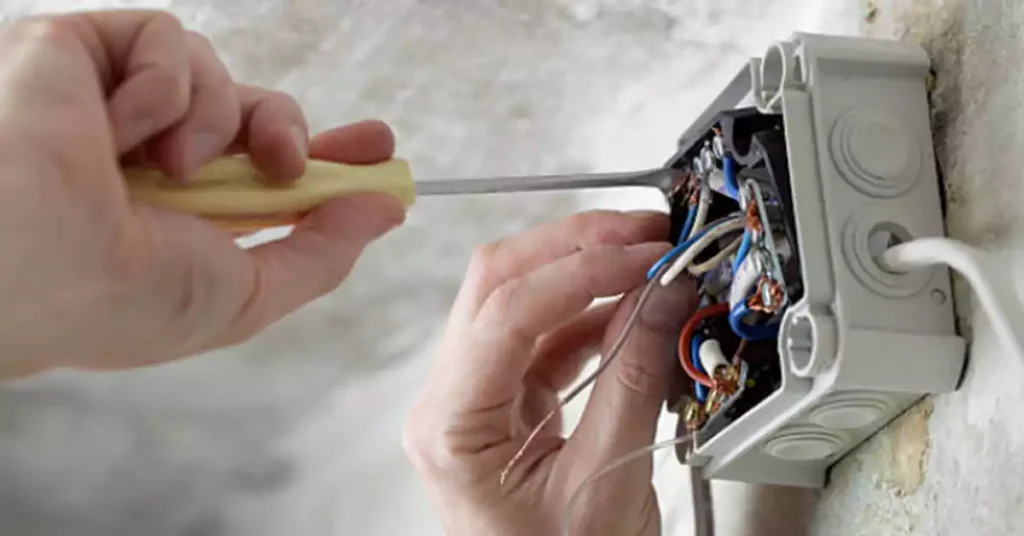
Achieving NEC compliance is about ensuring that every part of an electrical installation is safe, code-compliant, and fit for long-term performance in real-world conditions. Whether you’re working on a residential upgrade, a commercial building construction, or an industrial-scale system, a systematic approach rooted in the National Electrical Code (NEC) is essential.
Here are some factors you need to know to complaint with NEC:
Define the Application Type
Start by identifying the occupancy type and specific systems involved. The NEC structures many of its rules around the nature of the building or system:
Residential, commercial, or industrial
Hazardous locations (e.g., petrochemical plants)
Special occupancies like healthcare, agriculture, data centers, or EV infrastructure
Will it include systems like fire alarms, emergency power, or communication cabling.
Identify the Correct Code Edition and Local Amendments
Always verify the NEC edition adopted in your region. While the NEC is updated every three years, not all states or jurisdictions immediately adopt the latest version. Also, many municipalities add local amendments that override or supplement NEC rules.
To stay compliant:
Confirm the NEC edition adopted locally (e.g., 2020, 2023)
Review any state-specific electrical codes.
Coordinate with the Authority Having Jurisdiction (AHJ) early in the design phase.
Evaluate the Installation Environment
Electrical materials and methods must be selected with field conditions in mind. The NEC emphasizes suitability based on:
Ambient temperature: Conductors must be derated when installed in high-temperature areas (e.g., attics, rooftops). See NEC 310.15(B).
Moisture and corrosion: Use watertight and corrosion-resistant enclosures and raceways in wet locations (e.g., outdoor, underground).
Exposure to sunlight: Materials installed in direct sunlight must be UV-resistant.
Physical damage potential: In areas subject to impact or movement, raceways must be heavy-duty or mechanically protected.
Select NEC-Compliant Wiring Methods and Materials
Refer to Chapter 3 for acceptable wiring methods based on the project environment and NEC scope. Choices must consider:
Conductor type and insulation (e.g., THHN, XHHW-2, MTW)
Conduit system (e.g., EMT, RMC, PVC, ENT)
Cable assemblies (e.g., NM, MC, AC cables)
Boxes, fittings, connectors, and support
All materials must be listed and labeled by a recognized third-party testing agency (e.g., UL, CSA) and used in accordance with their listing.
For Special Occupancies and Equipment
If your project includes special occupancies or special equipment, apply specific rules beyond general wiring practices. Examples:
Healthcare: Requires isolated grounding, redundant circuits, and essential system separation.
Ubicaciones peligrosas: Mandates explosion-proof fittings and sealed conduit systems.
Agricultural Buildings: Require corrosion-resistant and dust-tight enclosures.
Fire Alarms: Must meet survivability and separation requirements.
NEC also defines clearances, circuit separation, and system labelling rules that are critical to safety and inspection.
Ensure Grounding and Bonding Integrity
Refer to NEC Article 250 for proper grounding and bonding, including:
Grounding electrode systems (e.g., ground rods, building steel)
Main and supplemental bonding jumpers
Equipment grounding conductors sized according to NEC Table 250.122
Improper grounding is one of the most common causes of NEC violations and electrical hazards.
Calculate Conduit Fill, Ampacity, and Voltage Drop
Proper wire sizing must consider:
Ampacity derating: Based on ambient temperature and number of conductors.
Conduit fill: Overfilling leads to overheating.
Voltage drop (recommended max 3% for branch circuits): Especially critical for long runs and energy-efficient designs.
Schedule Inspections
Coordinate with the AHJ for inspection stages, such as:
Rough-in inspections: Check wiring, supports, and boxes before finishes are applied.
Final inspections: Ensure proper device installation, labeling, grounding, and safety clearances.
Additionally, perform system tests like:
Continuity and insulation resistance
Polarity and GFCI/AFCI verification
Load balancing and voltage readings
For commercial and industrial systems, commissioning and third-party validation may be required.
The NEC provides a consistent framework for safe, functional electrical installations, but true compliance requires more than just code references. Professionals must consider installation environments, equipment ratings, material compatibility, and local rules every step of the way.
By following this structured guide and aligning each phase of your installation to NEC provisions, you can deliver systems that are safe, efficient, and future-proof.
10 Commons NEC Violations and How to Avoid Them
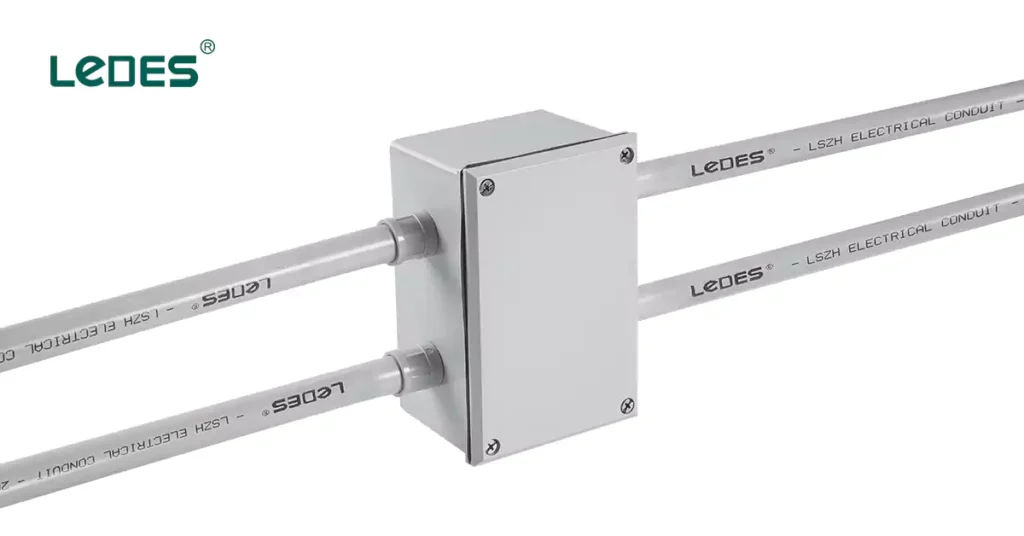
Even skilled electricians and experienced contractors can encounter National Electrical Code (NEC) violations, many of which are surprisingly avoidable. These missteps can delay project approvals, create safety hazards, or lead to costly rework. Understanding the most common pitfalls and how to prevent them is key to maintaining both compliance and safety.
Here are several frequently encountered NEC violations, along with practical advice on how to avoid them.
Inadequate Grounding and Bonding
One of the most frequent issues in electrical installations is poor or missing grounding and bonding. This can lead to equipment damage, shock hazards, or unreliable system performance.
Cómo evitarlo:
Ensure all metal components and systems are properly bonded and connected to an effective ground. Use appropriate connectors and follow correct installation practices for grounding electrodes and conductors. Never rely on flexible metal conduits or enclosures as the sole path to ground.
Overfilled Junction or Outlet Boxes
Stuffing too many wires into a single electrical box without accounting for space requirements can lead to overheating or damaged insulation.
Cómo evitarlo:
Always size electrical boxes according to the number and size of wires, devices, and clamps inside. Use larger boxes or box extensions when needed. Plan box fill before pulling conductors to avoid overfilling during installation.
Conduit Overfill and Poor Bending Practices
Running too many wires through a single conduit or using sharp, cramped bends can make maintenance difficult and lead to wire damage.
Cómo evitarlo:
Limit the number of wires in each conduit to prevent excessive heat buildup. Maintain proper bending radii to ensure easy wire pulling and avoid stress on the insulation. Choose conduit sizes that allow for future wiring adjustments.
Missing GFCI or AFCI Protection
Omitting required safety protection, such as Ground-Fault Circuit Interrupters (GFCIs) or Arc-Fault Circuit Interrupters (AFCIs), is a common oversight—especially in kitchens, bathrooms, outdoor spaces, or bedrooms.
Cómo evitarlo:
Know where these devices are required and include them in both design and installation phases. Use labeled GFCI/AFCI receptacles or breakers, and test them after installation.
Loose or Unsupported Cables and Conduits
Failing to secure cables or conduits can cause sagging, mechanical damage, or even failure under stress or vibration.
Cómo evitarlo:
Support all wiring methods securely with proper fasteners at regular intervals. Avoid over-tightening straps, and use approved supports compatible with the conduit or cable type.
Using Incorrect Connectors or Fittings
Improvised or incompatible fittings can result in poor electrical continuity, mechanical weakness, or moisture intrusion.
Cómo evitarlo:
Only use listed connectors and fittings that match the type and size of conduit or cable being used. Avoid mixing metal and plastic components unless specifically approved.
Ignoring Temperature Ratings or Ampacity Adjustments
Neglecting to consider high ambient temperatures, insulation type, or bundled conductors can lead to overheating and premature equipment failure.
Cómo evitarlo:
Use wire types with insulation suitable for the environment, and adjust ampacity when cables are bundled or installed in hot areas like attics or near heating systems. Select conduit materials that perform well in those temperatures.
Poor Identification of Conductors
Using the wrong color or failing to label wires clearly can confuse maintenance personnel or lead to unsafe connections.
Cómo evitarlo:
Follow consistent wire color conventions: black or red for hot wires, white or gray for neutrals, and green or bare copper for grounding. When color is unclear, label conductors clearly at both ends.
Insufficient Working Space Around Panels
Installing panels in cramped or obstructed areas makes safe operation and maintenance difficult—and can lead to code violations during inspection.
Cómo evitarlo:
Ensure that electrical panels and service equipment have clear, unobstructed access with adequate working space in front and around them. Avoid placing panels in closets, bathrooms, or storage spaces.
Lack of Weatherproofing in Outdoor Installations
Failing to use weather-resistant materials outdoors or in wet locations can lead to corrosion, water damage, and dangerous short circuits.
Cómo evitarlo:
Use weatherproof boxes, covers, fittings, and conduit suitable for wet or damp environments. Seal all connections carefully and install covers that protect outlets even while in use.
Staying Updated with the NEC - 3 Tips
The National Electrical Code (NEC) is not a static document—it is revised cada tres años to reflect changes in technology, safety practices, and the evolving needs of the electrical industry. Staying updated is not just recommended—it’s essential for compliance, performance, and safety.
Here are some points you can follow to ensure remain NEC-compliant and up to date.
Staying Compliant Through Education and Training
Continuing Education
Licensing authorities in many jurisdictions require electricians, engineers, and contractors to complete continuing education to renew their licenses. These courses typically cover updates in the latest NEC edition, with a focus on changes in definitions, requirements, and safety standards.
Manufacturer and Industry Training
Many conduit, wiring, and equipment manufacturers offer product-specific training aligned with NEC updates. These sessions help professionals apply code requirements to real-world products and systems, especially in emerging fields like EV charging infrastructure and solar energy.
On-the-Job Experience and Mentoring
For apprentices and journeymen, learning on-site under the guidance of a master electrician is one of the most practical ways to build NEC knowledge. Experienced professionals often share field-proven practices that align with code requirements while improving installation efficiency and quality.
The Role of Inspections and Permits
Electrical Permits Ensure Compliance Before Work Begins
Before most electrical work can begin, contractors must apply for a permit. This process ensures that the design and scope of work meet NEC standards and local amendments.
Inspections Catch Mistakes and Improve Safety
Inspections are conducted at critical phases of a project—often before walls are closed and again after completion. Inspectors act as an essential line of defense, verifying installations are safe, code-compliant, and professionally executed.
Working With Inspectors, Not Against Them
Professionals who view inspectors as allies—not obstacles—tend to deliver better projects. A good relationship with local authorities can streamline approvals and improve understanding of evolving code interpretations.
Essential Resources for NEC Compliance
NFPA 70: National Electrical Code Handbook
The NEC Handbook, published by the National Fire Protection Association (NFPA), provides the full text of the Code with expert commentary, illustrations, and real-world application notes. It’s an indispensable tool for in-depth learning and design reference.
NEC Mobile App and Digital Access
NFPA also offers the NEC in a mobile app, making it easy to search, bookmark, and reference sections in the field. Many professionals use the app as a fast and reliable way to find answers on-site.
Local Code Amendments
Each city or state may adopt the NEC with additions or modifications. Always check with your local Authority Having Jurisdiction (AHJ) to confirm which edition is in force and whether any unique rules apply to your project.
Trade Associations and Online Communities
Organizations like IAEI (International Association of Electrical Inspectors), NECA (National Electrical Contractors Association), and IEC (Independent Electrical Contractors) provide access to training, publications, and forums where professionals can discuss code questions and stay updated on industry trends.
Conclusión
The National Electrical Code (NEC) is more than just a rulebook—it’s the foundation of electrical safety across the United States and beyond. It represents decades of industry experience, real-world lessons, and engineering standards that aim to protect people, property, and electrical systems.
One of the most critical aspects of NEC compliance is choosing the right electrical conduit. Whether it’s PVC for underground runs, EMT for commercial interiors, or specialized low-smoke halogen-free solutions for sensitive environments, conduit selection directly affects safety, performance, and code adherence. Using properly rated conduits not only ensures regulatory compliance but also contributes to long-term system durability and resilience.
Ultimately, following the NEC leads to safer electrical installations, reduced fire and shock hazards, and fewer costly reworks or legal issues. For electrical professionals, contractors, inspectors, and engineers, understanding and applying the NEC is not just a requirement—it’s a commitment to quality and safety in every project.
Preguntas frecuentes
What is the National Electrical Code (NEC)?
The National Electrical Code (NEC) is a set of standardized guidelines developed by the National Fire Protection Association (NFPA) for the safe installation of electrical wiring and equipment in the United States. Updated every three years, the NEC aims to protect people and property from electrical hazards such as shock, fire, and arc flash. It covers everything from wiring methods and conduit types to grounding, special occupancies, and renewable energy systems.
Is the National Electrical Code a law?
Technically, the NEC itself is not a law, but it becomes legally enforceable when adopted by state or local jurisdictions as part of their building codes. Most U.S. states and territories adopt the NEC (often with amendments), making it a de facto legal requirement in those areas. Compliance is typically enforced by local electrical inspectors.
Do all countries have a National Electrical Code?
No, not all countries have a version of the NEC. The NEC is primarily used in the United States, although some other countries, especially in Latin America and the Caribbean, may use it or base their standards on it. Other countries typically have their own national electrical standards, such as:
IEC standards (International Electrotechnical Commission) used in Europe and many parts of Asia and Africa
Código Eléctrico Canadiense (CEC) in Canada
AS/NZS 3000 (Wiring Rules) in Australia and New Zealand
Is using a PVC pipe for an electrical conduit bad?
Yes. Only specific types of PVC conduit are approved for electrical use—you cannot use regular plumbing PVC (typically white Schedule 40 or 80) as an electrical conduit.
For electrical installations, you must use electrical-grade PVC conduit such as:•
- Rigid Polyvinyl Chloride Conduit (PVC Schedule 40 or 80) — marked and listed for electrical use
- Tubería eléctrica no metálica (ENT) — also made of PVC, flexible, and used in certain wall or ceiling applications
These conduits:
- Are listed and labeled for electrical safety
- Provide protection against corrosion and moisture
- Must be installed following NEC requirements regarding bends, supports, burial depth, and temperature ratings
Using plumbing-grade PVC for electrical wiring is unsafe and non-compliant, as it may not have flame resistance, UV protection, or dimensional consistency required for pulling conductors.
Can I run a ground wire along the outside of a conduit?
No, running a ground wire along the outside of a conduit is not compliant with the NEC. Grounding conductors must be:
- Inside the raceway or cable assembly
- Protected from physical damage
- Installed in a way that ensures electrical continuity and conductivity
Exposed grounding conductors are susceptible to mechanical damage and corrosion, which can compromise safety.
According to the NEC, what is a power outlet?
According to the NEC, a power outlet refers to a point on the wiring system at which current is taken to supply utilization equipment. In practical terms, this typically means a receptacle outlet where you plug in appliances or devices. However, the term may also apply to other outlets like lighting, motor, or equipment outlets depending on the context.
What is the latest edition of the National Electrical Code (NEC)?
The latest edition is the 2023 NEC, published by the National Fire Protection Association (NFPA). It is updated every three years.
What regulations cover electrical installations?
Electrical installations in the U.S. are primarily governed by the NEC (NFPA 70). Local jurisdictions may adopt the NEC with or without amendments and may also have their own building or energy codes. In Canada, are primarily governed by the CEC ( Canadian Electrical Code), different regions may have local codes themselves.
Is it legal to do your own electrical work in the United States?
Yes, but it depends on the state and local jurisdiction. In many areas, homeowners may perform certain electrical work on their own homes if they obtain the proper permits and pass inspections. However, commercial work or high-voltage systems usually require a licensed electrician.
Referencias


